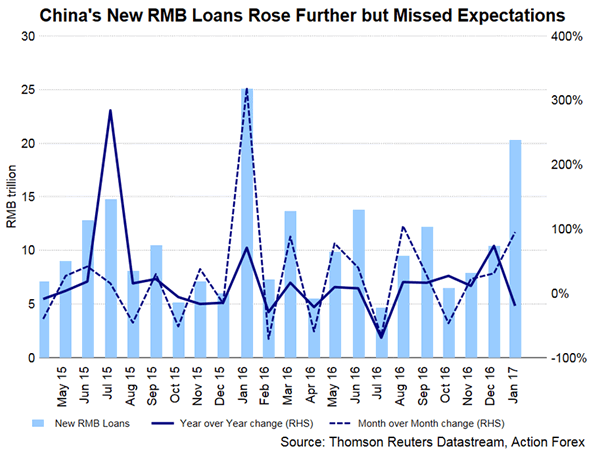In PBOC’s latest set money report, China’s new renminbi loans rose to RMB 2.03 trillion in January. However, it came in below consensus of RMB 2.44 trillion and RMB 2.5 trillion the same period last year. Although it is usual for new loans to be high earlier in a year as banks front-load their loans for profit maximization, the January figure missed expectations as lending to non-bank financial institutions fell for the month. Outstanding renminbi loans growth decelerated to +12.6% y/y, from +13.5% in December. Medium and long term corporate bank lending, a barometer of corporate sector demand, increased +43.4% y/y to RMB 1.52 trillion, whilst medium- and long-term household loans, mainly mortgage loans, rose to a record high of RMB 0.63 trillion. This suggests that PBOC’s recent tightening measures have yet to feed through the housing market. We believe a few months’ data would be needed to see the effectiveness of these measures..

Overall, total social financing (TSF), before adding local government bond net issuance, rose to RMB 3.74 trillion in January, up from December’s RMB 1.63 trillion. Adjusted TSF stock expanded +15.5% y/y in January, slowing from +15.7% a month ago. According to PBOC, TSF stock growth (not adjusting for local government bond issuance) grew +12.8%y/y in January, easing from around +13% in December. On the money supply, growth in broad money supply (M2) has decelerated for a third straight month, easing to +11.3% y/y, in January. We believe a critical factor dragging on M2 growth is ongoing capital outflow. The decline in FX reserve to US$2.998 trillion, the lowest since early 2011, in January, has already sent initial evidence that capital outflow remained so severe that PBOC had to intervene in the FX market. Last Friday, SAFE reported net sales of US$19.2B worth of FX in January, compared with US$46.3B and US$ 33.4B in December and November, respectively. According to SAFE, the diminished sales amount signaled that pressure from capital outflow “has been remarkably alleviated since 2017”. It added that, “despite external uncertainties, China’s sound economic fundamentals will determine stable cross-border capital flows in the medium and long run”. In our opinion, the diminished figure was merely helped US dollar’s depreciation during the period


Inflation came in higher than expected in January. Headline CPI accelerated to a 32-month high of +2.5% y/y, from +2.1% in December. While high energy prices and Lunar New Year effect did helped push inflation higher, the core reading suggested that the underlying trend has also improved. Core inflation, excluding food and energy, rose to+2.2% y/y in January, from +1.9% a month ago. Food inflation increased +2.7% y/y, up from +2.4% previously, whilst nonfood inflation rose to +2.5% y/y, from +2% in December. Upstream PPI jumped +6.9% y/y in January, after a +5.5% expansion in the prior month.
Strong inflation would give room for PBOC to continue monetary tightening. In early February, PBOC raised interest rates of 7-, 14- and 28-day reverse repos by +10bps each to 2.35%, 2.5% and 2.65% respectively. It also lifted the overnight SLF rate to 3.1% from 2.75% previously. The move has sparked speculations for further tightening, especially the loan data above confirmed that mortgage lending remained strong in January.














